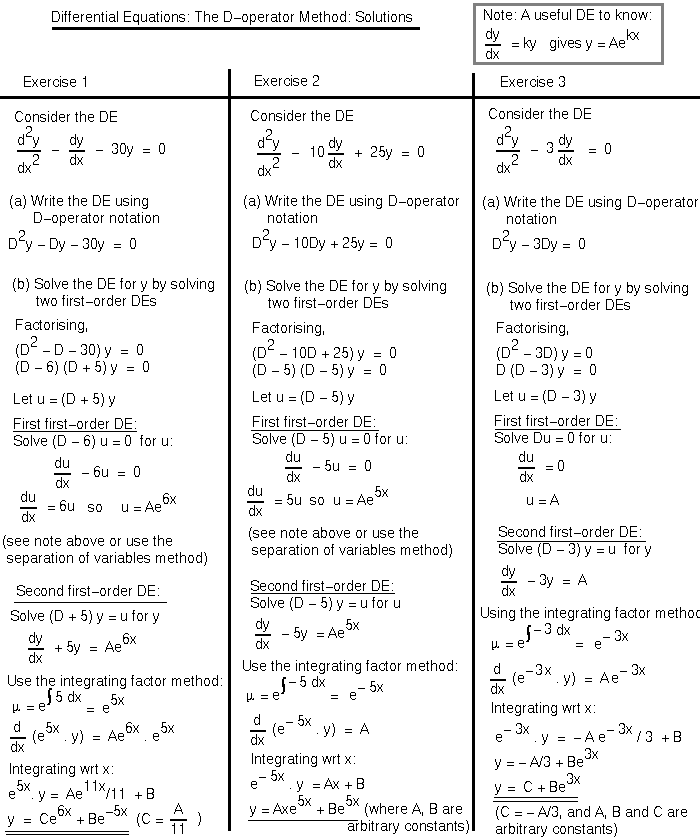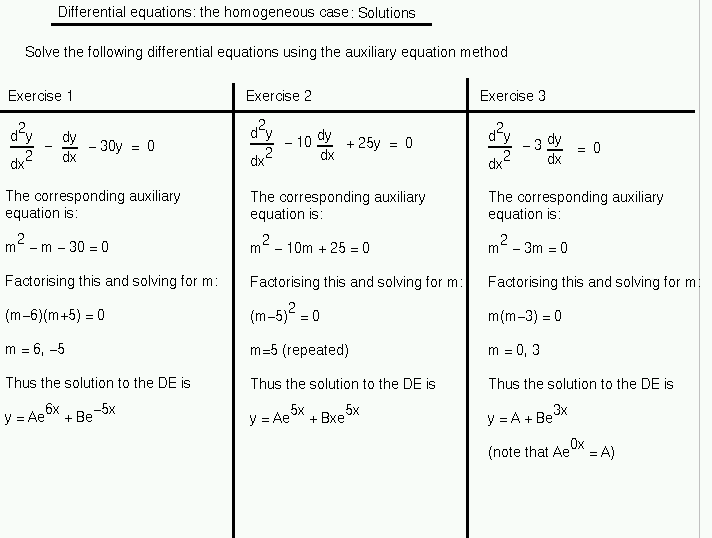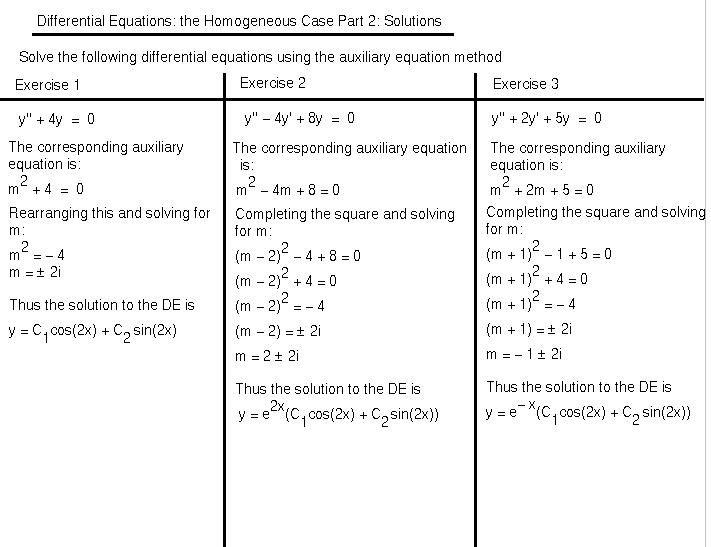How to Identify Which Differential Equation Method to Use
Put the differential equation in the correct initial form 1 1. Keep in mind that you may need to reshuffle an equation to identify it.

Differential Equations Math100 Revision Exercises Resources Mathematics And Statistics University Of Canterbury New Zealand
1 the method of undetermined coefficients and 2 the method of variation of parameters.

. Finding particular solutions using initial conditions and separation of variables. Solving First Order Differential Equations with ode45 The MATLAB commands ode 23 and ode 45 are functions for the numerical solution of ordinary differential equations. The two most common methods when finding the particular solution of a non-homogeneous differential equation are.
A first order Differential Equation is Homogeneous when it can be in this form. After separating the variables the solution of the differential equation can be determined easily by integrating both sides of the equation. And dy dx d vx dx v dx dx x dv dx by the Product Rule Which can be simplified to dy dx v x dv dx.
You can classify DEs as ordinary and partial Des. Method of Undetermined Coefficients. V V initial Q i Q o t.
With this type of growth a populations change is directly proportional to its current size. We give an in depth overview of the process used to solve this type of differential equation as well as a derivation of the formula needed for the integrating factor used in the solution process. Separation of variables Integrating factor Differential Equation 122318 Separation of the variable is done when the differential equation can be written in the form of dydx f yg x where f is the function of y only and g is the function of x only.
To show that satisfies the differential equation we start by calculating This gives Next we substitute both and into the left-hand side of the differential equation and simplify. Here are some examples. Dy dx F y x We can solve it using Separation of Variables but first we create a new variable v y x.
Differential equations in this form are called Bernoulli Equations. Multiply everything in the differential equation by μt μ t and verify that the left side becomes the product rule μtyt μ t y t and write it as such. Ax dydx bx y cx 0.
So how can we tell whether an equation is separable. Next we calculate This result verifies the initial value. Lets start with a general first order IVP.
A 0 xy n a 1 xy n-1 a n xy r x The function a j x 0 j n are called the coefficients of the linear equation. They use the Runge-Kutta method for the solution of differential equations. Dy dt f ty yt0 y0 1 1 d y d t f t y y t 0 y 0.
This method was originally devised by Euler and is called oddly enough Eulers Method. Linear differential equations involve only derivatives of y and terms of y to the first power not raised to any higher power. An n-th order ordinary differential equations is linear if it can be written in the form.
If r x0 it is said to be a non- homogeneous equation. From the command line. Where px p x and qx q x are continuous functions on the interval were working on and n n is a real number.
As we will see finding Ψxy Ψ x y can be a somewhat lengthy process in which there is the chance of mistakes. As t goes by the initial volume changes depending on the flow rates. From this reasoning we can express V in terms of time.
Differential equations in the form y pt y gt. Yptyqty gt where gt is a non-zero function. There exist two methods to find the solution of the differential equation.
This is equal to the right-hand side of the differential equation so solves the differential equation. For the total volume V we know that it is 40L when t0. Or y 2x2c x.
Linear Equations In this section we solve linear first order differential equations ie. Separable differential equations can be written in the form dydx f x g y where x and y are the variables and are explicitly separated from each other. One of the most common differential equations is a first-order differential equation.
We are going to look at one of the oldest and easiest to use here. Also can turn into when divided by and multiplied by. The equation is said to be homogeneous if r x 0.
V y x which is also y vx. A differential equation of first order will have the following form. But because of different inflow and outflow rates we say that the volume in the tank is not 40L as time t goes by.
This is the solution for the given equation. As the name suggests ie variable seprable see wheather their is common in x nd y coeffecients nd then the equation can be easily seprated between x. Reduction of order is a method in solving differential equations when one linearly independent solution is known.
A linear nonhomogeneous differential equation of second order is represented by. The method works by reducing the order of the equation by. One example of a real-world phenomenon you can model with a first-order differential equation is exponential growth.
In this section we are going to take a look at differential equations in the form y pxy qxyn y p x y q x y n. In addition to this distinction they can be further distinguished by their order. 1 By variable separable.
Differential equations that can be solved using separation of variables are called separable equations. For example can turn into when multiplied by and. The second uses Simulink to model and solve a differential equation.
Find the integrating factor μt μ t using 10 10. The most common type are equations where is equal to a product or a quotient of and. This is the currently selected item.
You can distinguish among linear separable and exact differential equations if you know what to look for. Finding the function Ψxy Ψ x y is clearly the central task in determining if a differential equation is exact and in finding its solution. The associated homogeneous equation is.
Solving a differential equation means finding the value of the dependent variable in terms of the independent variable.

Differential Equations Math100 Revision Exercises Resources Mathematics And Statistics University Of Canterbury New Zealand

How To Solve Differential Equations By Substitution Youtube

Differential Equations Math100 Revision Exercises Resources Mathematics And Statistics University Of Canterbury New Zealand

Comments
Post a Comment